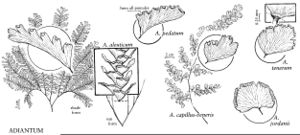Difference between revisions of "Adiantum capillus-veneris"
Sp. Pl. 2: 1096. 1753.
FNA>Volume Importer |
imported>Volume Importer |
||
| (6 intermediate revisions by 2 users not shown) | |||
| Line 8: | Line 8: | ||
}} | }} | ||
|common_names=Venus's-hair fern;southern maidenhair | |common_names=Venus's-hair fern;southern maidenhair | ||
| + | |special_status={{Treatment/ID/Special_status | ||
| + | |code=F | ||
| + | |label=Illustrated | ||
| + | }} | ||
|basionyms= | |basionyms= | ||
|synonyms={{Treatment/ID/Synonym | |synonyms={{Treatment/ID/Synonym | ||
|name=Adiantum capillus-veneris var. modestum | |name=Adiantum capillus-veneris var. modestum | ||
|authority=(L. Underwood) Fernald | |authority=(L. Underwood) Fernald | ||
| − | }}{{Treatment/ID/Synonym | + | |rank=variety |
| + | }} {{Treatment/ID/Synonym | ||
|name=Adiantum capillus-veneris var. protrusum | |name=Adiantum capillus-veneris var. protrusum | ||
|authority=Fernald | |authority=Fernald | ||
| − | }}{{Treatment/ID/Synonym | + | |rank=variety |
| + | }} {{Treatment/ID/Synonym | ||
|name=Adiantum capillus-veneris var. rimicola | |name=Adiantum capillus-veneris var. rimicola | ||
|authority=(Slosson) Fernald | |authority=(Slosson) Fernald | ||
| + | |rank=variety | ||
}} | }} | ||
|hierarchy=Pteridaceae;Adiantum;Adiantum capillus-veneris | |hierarchy=Pteridaceae;Adiantum;Adiantum capillus-veneris | ||
| Line 33: | Line 40: | ||
|elevation=0–2500 m | |elevation=0–2500 m | ||
|distribution=B.C.;Ala.;Ariz.;Ark.;Calif.;Colo.;Fla.;Ga.;Ky.;La.;Miss.;Mo.;Nev.;N.Mex.;N.C.;Okla.;S.C.;S.Dak.;Tenn.;Tex.;Utah;Va.;Mexico;West Indies;Central America;South America in Venezuela;Peru;tropical to warm temperate regions in Eurasia and Africa. | |distribution=B.C.;Ala.;Ariz.;Ark.;Calif.;Colo.;Fla.;Ga.;Ky.;La.;Miss.;Mo.;Nev.;N.Mex.;N.C.;Okla.;S.C.;S.Dak.;Tenn.;Tex.;Utah;Va.;Mexico;West Indies;Central America;South America in Venezuela;Peru;tropical to warm temperate regions in Eurasia and Africa. | ||
| − | |discussion=<p>No evident pattern to morphologic variation in the species is discernible, although a number of segregate species and infraspecific taxa have been recognized within North American Adiantum capillus-veneris. In the Eastern Hemisphere, the species is diploid, with 2n = 60 (I. Manton 1950). Several tetraploid counts have been reported from North America (W. H. Wagner Jr. 1963). Spore-measurement data suggest, however, that the polyploid cytotype may not be widely distributed. Further investigation is needed to determine whether Adiantum capillus-veneris populations in North America are conspecific with those in Eurasia and Africa.</p> | + | |discussion=<p>No evident pattern to morphologic variation in the species is discernible, although a number of segregate species and infraspecific taxa have been recognized within North American <i>Adiantum capillus-veneris</i>. In the Eastern Hemisphere, the species is diploid, with 2n = 60 (I. Manton 1950). Several tetraploid counts have been reported from North America (W. H. Wagner Jr. 1963). Spore-measurement data suggest, however, that the polyploid cytotype may not be widely distributed. Further investigation is needed to determine whether <i>Adiantum capillus-veneris</i> populations in North America are conspecific with those in Eurasia and Africa.</p> |
|tables= | |tables= | ||
|references= | |references= | ||
| Line 42: | Line 49: | ||
-->{{#Taxon: | -->{{#Taxon: | ||
name=Adiantum capillus-veneris | name=Adiantum capillus-veneris | ||
| − | |||
|authority=Linnaeus | |authority=Linnaeus | ||
|rank=species | |rank=species | ||
| Line 56: | Line 62: | ||
|publication title=Sp. Pl. | |publication title=Sp. Pl. | ||
|publication year=1753 | |publication year=1753 | ||
| − | |special status= | + | |special status=Illustrated |
| − | |source xml=https:// | + | |source xml=https://bitbucket.org/aafc-mbb/fna-data-curation/src/2e0870ddd59836b60bcf96646a41e87ea5a5943a/coarse_grained_fna_xml/V2/V2_208.xml |
|genus=Adiantum | |genus=Adiantum | ||
|species=Adiantum capillus-veneris | |species=Adiantum capillus-veneris | ||
Latest revision as of 20:22, 5 November 2020
Stems short-creeping; scales golden brown to medium brown, concolored, iridescent, margins entire or occasionally with single broad tooth near base. Leaves lax-arching or pendent, closely spaced, 15–75 cm. Petiole 0.5–1.5 mm diam., glabrous, occasionally glaucous. Blade lanceolate, pinnate, 10–45 × 4–15 cm, glabrous, gradually reduced distally; proximal pinnae 3(–4)-pinnate; rachis straight to flexuous, glabrous, not glaucous. Segment stalks 0.5–3.5 mm, dark color extending into segment base. Ultimate segments various, generally cuneate or fan-shaped to irregularly rhombic (plants in American southwest occasionally with segments nearly round), about as long as broad; base broadly to narrowly cuneate; margins shallowly to deeply lobed, incisions 0.5–7 mm, occasionally ± laciniate, sharply denticulate in sterile segments; apex rounded to acute. Indusia transversely oblong or crescent-shaped, 1–3(–7) mm, glabrous. Spores mostly 40–50 µm diam. 2n = 120.
Phenology: Sporulating spring–summer.
Habitat: Moist calcareous cliffs, banks, and ledges along streams and rivers, walls of lime sinks, canyon walls (in the American southwest), around foundations, on mortar of storm drains
Elevation: 0–2500 m
Distribution

B.C., Ala., Ariz., Ark., Calif., Colo., Fla., Ga., Ky., La., Miss., Mo., Nev., N.Mex., N.C., Okla., S.C., S.Dak., Tenn., Tex., Utah, Va., Mexico, West Indies, Central America, South America in Venezuela, Peru, tropical to warm temperate regions in Eurasia and Africa.
Discussion
No evident pattern to morphologic variation in the species is discernible, although a number of segregate species and infraspecific taxa have been recognized within North American Adiantum capillus-veneris. In the Eastern Hemisphere, the species is diploid, with 2n = 60 (I. Manton 1950). Several tetraploid counts have been reported from North America (W. H. Wagner Jr. 1963). Spore-measurement data suggest, however, that the polyploid cytotype may not be widely distributed. Further investigation is needed to determine whether Adiantum capillus-veneris populations in North America are conspecific with those in Eurasia and Africa.
Selected References
None.
